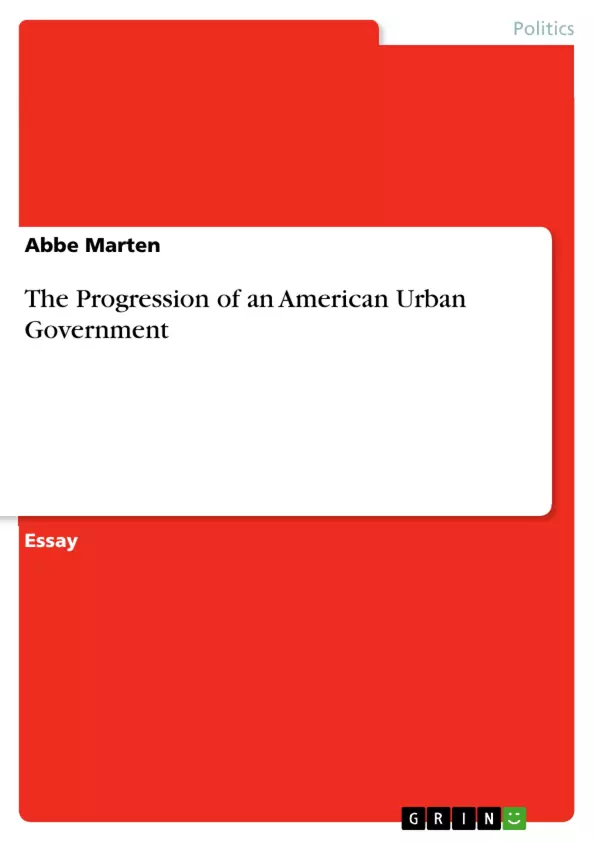During the Revolutionary War, the thirteen colonies that made up America did not have a central government and were only just forming independent state government. Through the first and second Constitutional Congress’, America united in its resistance against Great Britain and adopted policies to abolish English authority over the colonies. This Continental Congress called for the colonies to form their own independent governments and they appointed five men to a committee to draft the declaration of independence. On July 4, 1776 the Constitutional Congress adopted the declaration of Independence which proclaimed the independence of America from the crown. However, now that the United States was a free nation, how should the new government be set up?
Inhaltsverzeichnis (Table of Contents)
- The Rise of the Federalists and Anti-Federalists
- The Ratification of the Constitution
- The Adoption of the Bill of Rights
- The Rise of the Urban Machines
- The Birth of Municipal Reform
- The City Commission Form of Government
- The City Manager Form of Government
Zielsetzung und Themenschwerpunkte (Objectives and Key Themes)
This text explores the political landscape of the United States during the 18th and 19th centuries, focusing on the development of national and local government structures. The text examines the contrasting philosophies of the Federalists and Anti-Federalists, the adoption of the Constitution and the Bill of Rights, and the rise of powerful political machines in urban areas. It then details the emergence of municipal reform movements and the evolution of different forms of city government, ultimately highlighting the evolving relationship between government and the people.
- The formation of the United States government and the struggle between federal and state power
- The role of political parties and ideologies in shaping government structures
- The rise of political machines in urban environments and their influence on local politics
- The development of municipal reform movements and their efforts to improve city governance
- The evolution of different forms of city government, including the commission and city manager models
Zusammenfassung der Kapitel (Chapter Summaries)
- The first chapter examines the emergence of two distinct political groups, the Federalists and Anti-Federalists, following the American Revolution. It delves into their contrasting views on the ideal form of government, specifically highlighting the Federalists' advocacy for a strong federal government and the Anti-Federalists' preference for a more decentralized system.
- The second chapter focuses on the ratification of the Constitution, outlining the Federalists' arguments in favor of the document and the Anti-Federalists' concerns about its potential to concentrate power in the hands of the federal government. It also explores the eventual adoption of the Constitution and the role of the Federalist Papers in swaying public opinion.
- The third chapter discusses the creation and adoption of the Bill of Rights, highlighting its purpose as a response to the Anti-Federalists' concerns about the protection of individual liberties. It outlines the key freedoms enshrined in the Bill of Rights, emphasizing its significance in securing essential rights for the American people.
- The fourth chapter analyzes the rise of urban political machines during the industrialization of the United States. It explores the emergence of these powerful organizations, their methods of operation, and the complex relationship between political bosses and the urban working class.
- The fifth chapter delves into the development of municipal reform movements, which sought to combat the perceived corruption and inefficiencies associated with political machines. It examines the efforts of civic reformers to establish alternative forms of city governance, emphasizing their focus on professional management and a more centralized approach to urban administration.
- The sixth chapter explores the city commission form of government, highlighting its structure, key functions, and its perceived limitations. It provides an overview of this early form of municipal governance and its eventual transition to the council-manager model.
- The seventh chapter examines the city manager form of government, contrasting its features with the city commission model. It discusses the concept of professional management in urban administration, emphasizing the influence of the Scientific Management movement on the development of this governance structure.
Schlüsselwörter (Keywords)
This text focuses on key concepts such as federalism, state rights, political parties, political machines, municipal reform, city commission government, and city manager government. It explores the dynamics of power between different levels of government and the evolution of governance structures in the United States, particularly during periods of rapid industrialization and urbanization.
- Citation du texte
- Abbe Marten (Auteur), 2015, The Progression of an American Urban Government, Munich, GRIN Verlag, https://www.grin.com/document/416993



